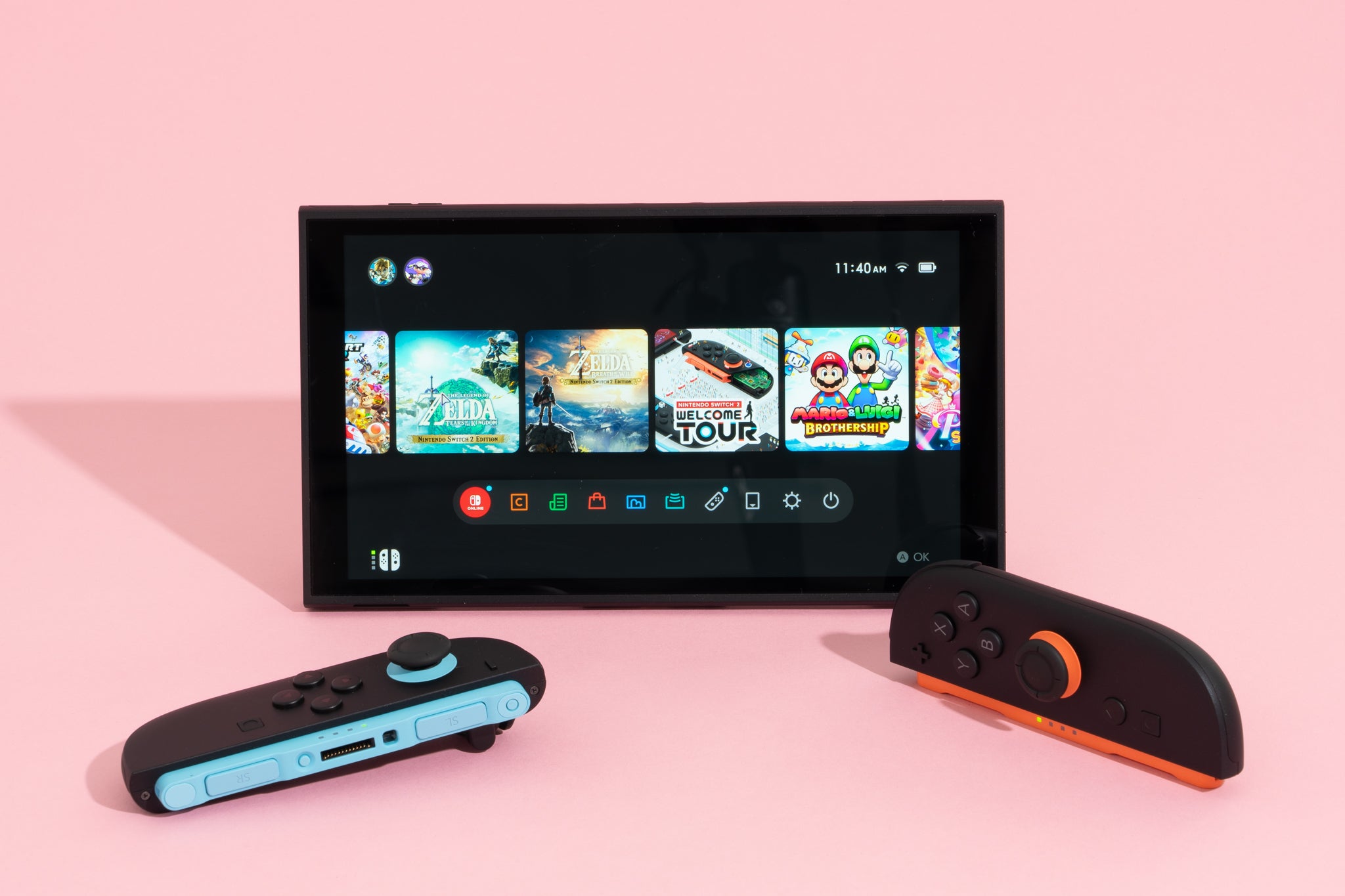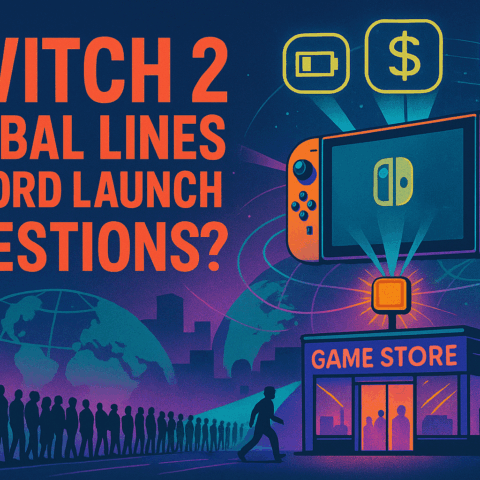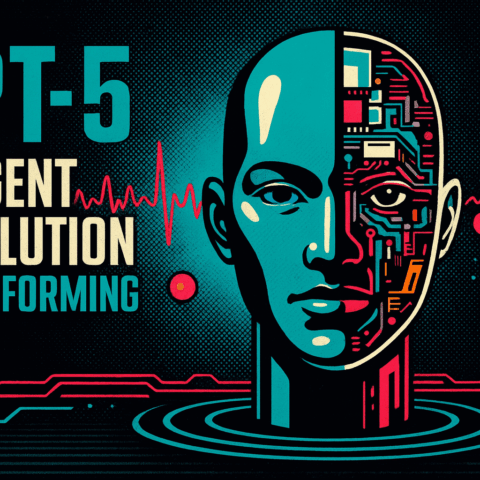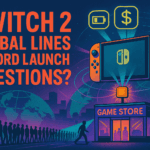The gaming industry witnessed history on June 5, 2025, as Nintendo launched its most ambitious console yet. The Switch 2’s record-breaking debut—3.5 million units sold in just four days— NintendoCNBCsignals not just another hardware launch, but a pivotal moment that could reshape Nintendo’s future in an increasingly competitive landscape. Nintendo +4 With its $450 price tag representing a 50% increase over its predecessor, CNN +5 sophisticated new features like AI-powered upscaling, and an unprecedented level of third-party support, the Switch 2 represents both Nintendo’s greatest opportunity and its riskiest gamble in years.
As the console enters a market dramatically different from the one its predecessor conquered in 2017, questions abound: Can Nintendo maintain its momentum against fierce competition from PC handhelds, cloud gaming services, and traditional console rivals? Will its bold pricing strategy pay off amid economic uncertainty and tariff concerns? And perhaps most critically, does the Switch 2 have what it takes to follow one of gaming’s most successful consoles ever? This comprehensive analysis examines every facet of Nintendo’s next-generation strategy, from cutting-edge hardware specifications to supply chain challenges, offering crucial insights for gamers, investors, and industry observers alike.
The hardware revolution Nintendo desperately needed
Nintendo’s engineering teams spent six years crafting the Switch 2, resulting in a console that delivers approximately 7.5 to 10 times the performance of its predecessor while maintaining the beloved hybrid design. Wikipedia At the heart of this leap lies the custom Nvidia T239 chip—a bespoke Ampere-based processor Beebombeebom that costs nearly double the original Switch’s Tegra X1 at an estimated $150 per unit. Lumafield +2 This silicon investment enables features previously impossible on Nintendo hardware: real-time ray tracing, DLSS AI upscaling NVIDIA Blog capable of transforming 540p handheld gameplay into crisp 1080p experiences, and support for demanding third-party titles like Cyberpunk 2077.
The 7.9-inch 1080p display marks a significant upgrade, offering 120Hz refresh rates and HDR support— PC GamerNintendospecifications that rival dedicated PC gaming handhelds. GamesRadar+ +4 When docked, the console pushes up to 4K resolution at 60 frames per second, NVIDIA Blog finally bringing Nintendo into the modern display era. GamesRadar+ +4 The console packs 12GB of high-speed LPDDR5X RAM, with 9GB available to developers— Tom’s HardwareWccftecha configuration that enables the system to run Unreal Engine 5 demos at performance levels that surprised even skeptical industry observers. Genkinintendo During private demonstrations at Gamescom 2023, Nintendo showcased The Matrix Awakens running with visual fidelity comparable to PlayStation 5 versions, leveraging DLSS 3.5 to achieve what Digital Foundry called “extraordinary efficiency” from relatively modest silicon. Videogames ChronicleVGChartz
Perhaps the most innovative hardware addition comes in the form of the redesigned Joy-Con 2 controllers. Beyond addressing the infamous drift issues through “ground-up redesign” (though notably without Hall effect sensors), these controllers introduce magnetic attachment mechanisms Wikipedia and integrated optical sensors that transform them into functional mice when detached. Tom’s Hardware +5 The GameChat system, activated by pressing the new C button, enables voice and video communication directly through the console— Epic DopeNintendoa feature Nintendo describes as bringing “the feeling of playing together in the same room even if friends and family are miles away.” Nintendo +5
Launch chaos and consumer frenzy define early reception
The Switch 2’s journey to consumers proved as dramatic as its technical specifications. Following delays caused by President Trump’s tariff policies, pre-orders finally opened on April 24, 2025, NPRRolling Stone triggering what industry observers called “the most chaotic hardware launch since the PlayStation 5.” WikipediaNewsweek Walmart, Best Buy, and Target’s websites buckled under unprecedented demand, leaving thousands of eager customers staring at frozen queue screens and error messages. CNBC +2 Those who persevered through the digital gauntlet found themselves among the lucky few—within hours, “out of stock” notifications dominated retailer websites nationwide.
Despite the pre-order pandemonium and premium pricing that sparked heated online debates, consumer enthusiasm remained undaunted. Launch day scenes across major cities resembled holiday shopping frenzies, with lines forming outside Nintendo stores hours before midnight releases. In the US alone, the console sold 1.6 million units in June 2025, shattering the previous record of 1.1 million set by the PlayStation 4 in November 2013. Ainvest +2 Mat Piscatella, Circana’s executive director, confirmed the Switch 2 as “the fastest selling video game hardware device in US history,” noting that consumer spending on both hardware and accessories reached all-time June records. VGChartzNasdaq
Hardware reviews painted a nuanced picture of Nintendo’s latest creation. Critics praised the premium build quality, with GameSpot noting it feels “less toy-like than the original Switch,” while Creative Bloq called it “absolutely state-of-the-art.” Metacritic The 86/100 Metacritic average for the hardware reflects general satisfaction, though reviewers consistently flagged concerns: the 2-6.5 hour battery life disappointed many expecting improvements over the original, nintendo +2 the lack of an OLED option at launch drew criticism from display enthusiasts, and the $450 price point generated spirited debate about value proposition. IGN’s measured 7/10 review captured the prevailing sentiment: “a vital upgrade” that mostly plays “catch-up” rather than revolutionizing the category. Metacritic
Games lineup signals Nintendo’s third-party transformation
The Switch 2’s software ecosystem represents perhaps the most dramatic shift in Nintendo’s platform strategy in decades. With over 25 launch titles and unprecedented third-party support, the console addresses historical criticisms about limited software diversity. Ampereanalysis +2 Mario Kart World leads the charge as the flagship exclusive, introducing 24-player races, open-world exploration, and seamless GameChat integration. CNN +2 Early sales figures—over 2 million copies despite being bundled with most consoles—and an 86/100 Metacritic score validate Nintendo’s decision to position this as the system seller. GameLuster
The third-party lineup reads like a wishlist of titles previously considered impossible on Nintendo hardware. Cyberpunk 2077 Ultimate Edition runs “seriously well” according to hands-on reports, delivering stable 30fps gameplay at 720p internal resolution upscaled to 1080p via DLSS when docked. WikipediaNintendo The game’s presence alone—jumping from 427th to 18th place in US sales charts following the Switch 2 launch—demonstrates the market’s hunger for premium experiences on Nintendo platforms. VGChartz Street Fighter 6, Yakuza 0 Director’s Cut, and confirmed upcoming releases like Borderlands 4 and Star Wars Outlaws cement the console’s position as a legitimate home for demanding third-party content. Wikipedia +4
Perhaps most intriguing are persistent reports of Microsoft bringing major franchises to Switch 2. Industry insiders including Windows Central corroborate that Halo: The Master Chief Collection and Microsoft Flight Simulator 2024 will arrive on the platform in 2025, with additional titles like Starfield potentially following. Wikipedia +3 This partnership, unthinkable just years ago, reflects the industry’s evolving dynamics and Nintendo’s newfound technical capabilities. Combined with robust backwards compatibility supporting over 15,000 Switch titles (though with notable exceptions requiring patches), Inverse the software proposition appears stronger than any previous Nintendo launch. Wikipedia +2
Market positioning reveals Nintendo’s calculated gamble
At $450, the Switch 2 enters a dramatically different competitive landscape than its predecessor faced in 2017. Nintendo +2 The console costs $50 more than a PlayStation 5 Digital Edition and sits uncomfortably close to the $499 Xbox Series X, while competing directly with Valve’s $399 Steam Deck in the portable space. CNN +2 Regional pricing variations compound the challenge: European consumers face €469.99 ($518 USD) due to taxes and import duties, while Japan enjoys a relatively affordable ¥49,980 ($340 USD) domestic price that helps maintain Nintendo’s home market dominance. 9meters
Industry analysts remain surprisingly bullish despite pricing concerns. Ampere Analysis projects 13 million units sold globally in 2025, while Wedbush’s Michael Pachter forecasts 18 million by June 2026. The Game Business +2 These optimistic predictions rest on several factors: Nintendo’s 129 million active Switch users provide a massive upgrade audience, Nintendo LifeNintendo Everything the hybrid form factor remains unique in the market, and exclusive franchises like Mario, Zelda, and Pokémon maintain their magnetic appeal. Wikipediaampereanalysis Early sales data validates these projections—VGChartz estimates show the Switch 2 nearly matching PlayStation 5’s entire year-to-date 2025 sales within its launch month alone. VGChartz
The handheld gaming market dynamics particularly favor Nintendo’s positioning. Despite increased competition from PC handhelds, that segment sold fewer than 1.5 million units total in 2024, down from 2.9 million in 2023. Nintendo LifeAccio The Switch 2’s first-month sales exceeded the entire PC handheld market’s annual performance, suggesting limited direct competition. DLSS technology provides a crucial differentiator against rivals—while the Steam Deck relies on AMD’s FSR upscaling, Nintendo’s Nvidia partnership enables what Digital Foundry calls performance improvements that “knock the Steam Deck completely out of the park” in efficiency terms.
Business strategy navigates unprecedented challenges
Nintendo’s financial strategy for the Switch 2 reflects both confidence and caution in equal measure. The company’s conservative forecast of 15 million units by March 2026 strikes analysts as deliberately modest—a typical Nintendo approach that provides room to exceed expectations. Nintendo Life Revenue projections of 1.9 trillion yen ($13 billion) for fiscal 2026 represent a 63% year-over-year increase, though notably fall short of analyst estimates. CNBC +2 The hardware itself carries significantly lower profit margins than the original Switch, with reports suggesting margins as thin as $4 per unit in the US market TweakTownDLCompare after accounting for the estimated $338 manufacturing cost and retail margins.
The Trump administration’s tariff policies created the most significant wild card in Nintendo’s launch planning. The complex web of duties—145% on Chinese electronics, 46% on Vietnamese imports (currently paused), and 24% on Japanese goods—forced Nintendo into an intricate manufacturing dance. CNN +6 By shifting 60% of US-bound production to Vietnam and stockpiling “hundreds of thousands” of units stateside before tariff implementation, Nintendo demonstrated remarkable supply chain agility. Nintendo Everything +2 President Shuntaro Furukawa acknowledged the challenge directly: “If additional tariffs are imposed and prices need to be adjusted, demand in the U.S. may decrease,” with potential profit impact reaching tens of billions of yen. CNBC +2
Stock market reaction tells a story of overwhelming confidence despite these challenges. Nintendo shares surged 46% in 2025, adding approximately $39 billion in market value and hitting fresh record highs following sales announcements. CNBC +3 Trading at 50x trailing earnings reflects investor belief that the Switch 2 will drive sustained growth. Nasdaq The strategic acquisition of Shiver Entertainment—specialists in demanding ports like Hogwarts Legacy—signals Nintendo’s commitment to maintaining robust third-party support throughout the console’s lifecycle. WikipediaGame Developer
Consumer reception and early market performance
The numbers speak volumes about consumer enthusiasm: 3.5 million units sold globally in four days established the Switch 2 as Nintendo’s fastest-selling console ever. Nintendo +5 In the United States, 1.6 million June sales shattered previous records, VGChartz while Japan contributed another 1.5 million units despite lottery systems attempting to manage demand. Ainvest +2 The 32% attach rate for the $70 Pro Controller and strong software sales—Mario Kart World ranking third in June despite digital sales and bundles not being counted—indicate consumers are investing heavily in the ecosystem despite premium pricing. VGChartzNintendo Everything
Pre-order chaos on April 24 revealed both massive demand and infrastructure inadequacies. Major retailers’ websites crumbled under the assault of eager buyers and automated bots, creating a familiar but frustrating experience for consumers. Wikipedia +3 Despite Nintendo’s anti-scalping measures—including purchase requirements of 12+ months Nintendo Switch Online membership and 50+ hours gameplay for direct sales—eBay listings quickly appeared at 60% markups. Wikipedia +2 Mat Piscatella’s post-launch analysis proved prescient: “What the launch sales primarily tell us is that they made a lot of Switch 2 to sell at launch,” while noting that Nintendo’s ability to maintain supply will determine long-term success. My Nintendo News
Critical reception has been generally positive but not without caveats. Hardware reviewers praise the premium feel and technical capabilities while lamenting the absence of an OLED option and disappointing battery life. The software lineup draws more unanimous praise, with journalists highlighting the dramatic improvement in third-party support. However, Nintendo’s decision not to provide review units before launch—citing “important features and updates” only available via day-one patches—generated controversy and forced media outlets into post-launch scrambles for coverage. Famiboards
Challenges mount as honeymoon period ends
Despite the record-breaking launch, Nintendo faces significant challenges in maintaining momentum. The 2-6.5 hour battery life represents a critical weakness in an increasingly mobile world, especially given the larger 5,220mAh battery that promised improvements. nintendo +3 Power consumption reaching 34.4W peaks raises concerns about heat management and long-term reliability. beebom The absence of Hall effect sensors in Joy-Con 2 controllers—attributed to magnetic attachment interference—risks repeating the drift controversy that plagued the original Switch and resulted in numerous lawsuits. LevelUpTom’s Hardware
Supply chain vulnerabilities persist despite diversification efforts. While Vietnam production helps mitigate China tariff exposure, component suppliers remain predominantly Chinese, creating potential bottlenecks. Nintendo Everything The 90-day pause on Vietnam tariffs expires in July 2025, potentially forcing price increases that could dampen demand. NiftyTraderSupply Chain Dive Nintendo’s acknowledgment that “other adjustments to the price of any Nintendo product are possible depending on market conditions” suggests the $450 launch price may not hold.
Software challenges loom as well. The $70-80 pricing for first-party titles represents a significant increase that may limit attach rates. The RingerAmpereanalysis Backward compatibility, while extensive, shows concerning gaps—popular titles like Doom Eternal, NBA 2K25, and Portal 2 face startup issues requiring patches. Epic Dope +4 The controversial Nintendo Switch 2 Welcome Tour, scoring a dismal 52/100 on Metacritic, became Nintendo’s worst-reviewed game in a decade, raising questions about software quality control. TheGamernintendo Most critically, the absence of DLSS implementation in many launch titles, including first-party releases, fails to showcase the hardware’s key differentiator. FamiboardsNeoGAF
Industry impact reshapes competitive dynamics
The Switch 2’s success reverberates throughout the gaming industry, validating hybrid gaming’s mainstream appeal while intensifying competition. Microsoft’s apparent willingness to bring marquee franchises to Nintendo platforms signals a fundamental shift in exclusivity strategies. Wikipedia +2 Sony faces pressure to respond, with rumors of a PlayStation Vita successor gaining credibility as portable gaming’s resurgence becomes undeniable. The traditional console war paradigm shifts toward ecosystem battles where content accessibility trumps hardware exclusivity.
Third-party publishers rush to capitalize on Nintendo’s expanded audience. Capcom, Sega, Ubisoft, and others announce ambitious Switch 2 support, recognizing the platform’s potential to reach audiences beyond traditional console demographics. Ampereanalysis +2 However, Matthew Ball’s analysis provides crucial context: “We should not think of the fact that Nintendo Switch 2 can run most third-party titles sufficiently as this massive new blue ocean opportunity for publishers… it’s going to be a new hotly contested platform.” thegamebusiness Publishers must now compete for attention on a Nintendo platform in ways previously unnecessary.
The technological implications extend beyond gaming. DLSS implementation in a $450 device demonstrates AI upscaling’s mass-market viability, potentially influencing everything from mobile devices to smart TVs. The success of GameChat’s integrated communication features could prompt competitors to reconsider their approach to social gaming. Nintendo USNintendo Even the magnetic Joy-Con attachment system, despite preventing Hall effect sensor adoption, showcases innovative approaches to modular hardware design that competitors will likely study and iterate upon. Nintendo USNintendo
Future outlook balances optimism with uncertainty
Long-term projections paint an optimistic picture tempered by acknowledged risks. DFC Intelligence forecasts 80 million units sold by 2028, positioning the Switch 2 to potentially match its predecessor’s remarkable trajectory. BlackFlix Analysts cite several supporting factors: the massive installed base of Switch owners ready to upgrade, minimal direct competition in the hybrid space, and Nintendo’s proven ability to deliver system-selling software throughout a console’s lifecycle. The confirmed development pipeline—including Metroid Prime 4: Beyond, Donkey Kong Bananza, and persistent rumors of a new 3D Mario—suggests steady momentum through 2025 and beyond. nintendo
Regional dynamics will play a crucial role in determining ultimate success. Japan’s enthusiasm remains undiminished, with the Switch 2 outselling PlayStation 5 and Xbox Series combined by substantial margins. Game RantVGChartz The US market’s resilience despite premium pricing surprises analysts, though sustained demand depends on economic conditions and potential tariff impacts. Europe’s price sensitivity at €469.99 creates the greatest challenge, potentially limiting Nintendo’s penetration in its second-largest market.
The software ecosystem’s evolution holds perhaps the greatest potential for surprise. If Microsoft follows through on bringing Game Pass or a curated selection to Switch 2, it could fundamentally alter the platform’s value proposition. Wikipedia Enhanced versions of Switch classics at $10-15 upgrade fees provide steady revenue streams while maintaining catalog value. Inverse The GameCube Virtual Console additions, starting with Wind Waker and F-Zero GX, tap nostalgia while showcasing the hardware’s emulation capabilities. Wikipedia +4 Most intriguingly, the improved hardware enables genres previously absent from Nintendo platforms—simulation games, realistic racing titles, and demanding RPGs—potentially expanding the audience beyond traditional Nintendo demographics.
Conclusion
The Nintendo Switch 2 represents far more than an iterative hardware upgrade—it embodies Nintendo’s vision for gaming’s future while acknowledging present realities. By delivering substantial technical improvements without abandoning the hybrid concept that resonated with 150 million Switch owners, Fortune +2 Nintendo threads a careful needle between innovation and familiarity. Wikipedia The record-breaking launch validates core decisions around pricing, features, and software strategy, even as challenges around battery life, component costs, and tariff exposure loom. Wikipedia
Success ultimately depends on Nintendo’s ability to execute across multiple fronts simultaneously. The company must maintain hardware supply amid geopolitical uncertainty, nurture unprecedented third-party relationships without compromising first-party excellence, and justify premium pricing through compelling exclusive content. Early indicators suggest Nintendo has positioned itself well—the combination of technical capability, software diversity, and brand loyalty creates a powerful foundation for sustained success.
As the gaming industry watches Nintendo’s next moves, the Switch 2’s impact extends beyond sales figures. It demonstrates that innovative form factors can still disrupt established categories, that premium pricing works when backed by compelling propositions, and that even giants like Microsoft will reconsider exclusivity when faced with market realities. BGR Whether the Switch 2 ultimately matches its predecessor’s extraordinary success remains uncertain, but its arrival has already reshaped industry dynamics in ways that will reverberate for years to come. For Nintendo, the gamble appears to be paying off—the question now becomes not whether the Switch 2 will succeed, but just how high it can soar.







![Meta's $300 million gamble reshapes the AI talent wars Meta has launched the most aggressive talent acquisition campaign in technology history, offering individual compensation packages up to $300 million over four years to elite AI researchers. CNBC +7 This unprecedented strategy, coupled with $60-65 billion in infrastructure investments for 2025, represents Mark Zuckerberg's all-in bet to transform Meta from an AI follower into the leader in the race toward superintelligence. Data Center Dynamics +5 The campaign has successfully recruited dozens of top researchers from OpenAI, Google DeepMind, and Apple, while fundamentally disrupting compensation norms across the entire AI industry and raising critical questions about talent concentration and the future of AI development. CNBC +8 The $300 million figure decoded: Individual packages, not aggregate spending The widely reported "$300 million AI brain drain" figure represents individual compensation packages for elite AI researchers over four-year periods, not Meta's total spending on talent acquisition. Gizmodo +3 According to Fortune's July 2025 reporting, "Top-tier AI researchers at Meta are reportedly being offered total compensation packages of up to $300 million over four years, with some initial year earnings exceeding $100 million." Fortune Yahoo Finance These packages primarily consist of restricted stock units (RSUs) with immediate vesting, rather than traditional signing bonuses, as Meta CTO Andrew Bosworth clarified: "the actual terms of the offer wasn't a sign-on bonus. It's all these different things." CNBC +2 The compensation structure includes base salaries up to $480,000 for software engineers and $440,000 for research engineers, Fortune supplemented by massive equity grants and performance bonuses. Fortune SmythOS Specific examples include Ruoming Pang from Apple receiving $200+ million over several years Fortune and Alexandr Wang from Scale AI receiving $100+ million as part of Meta's $14.3 billion investment in Scale AI. Fortune +3 OpenAI CEO Sam Altman confirmed these figures on the "Uncapped" podcast, stating Meta made "giant offers to a lot of people on our team, you know, like $100 million signing bonuses, more than that (in) compensation per year." CNBC +6 This compensation strategy emerged after Meta's Llama 4 model underperformed expectations in April 2025, prompting Zuckerberg to take personal control of recruitment. CNBC +3 The CEO maintains a "literal list" of 50-100 elite AI professionals he's targeting, making direct phone calls to recruit them. Fortune +5 While not every hire receives nine-figure packages—typical offers range from $10-18 million annually—the peak compensation levels have redefined industry standards and forced competitors to dramatically increase their retention spending. TechCrunch Meta raids the AI elite: Key acquisitions from competitors Meta's talent acquisition campaign has systematically targeted the architects of competitors' most successful AI models, with particular focus on researchers with expertise in reasoning models, multimodal AI, and foundation model training. SmythOS Fortune The company has successfully recruited 11+ researchers from OpenAI, including several co-creators of ChatGPT and the o-series reasoning models. South China Morning Post +4 Notable acquisitions include Shengjia Zhao, named Chief Scientist of Meta Superintelligence Labs in July 2025, who co-created ChatGPT, GPT-4, and all mini models; CNN Trapit Bansal, a key contributor to OpenAI's o1 reasoning model who pioneered reinforcement learning approaches; TechCrunch TechCrunch and Hongyu Ren, co-creator of GPT-4o, o1-mini, and o3. CNBC +2 From Google DeepMind, Meta secured Jack Rae, the pre-training tech lead for Gemini who also led development of Gopher and Chinchilla; Pei Sun, who led post-training, coding, and reasoning for Gemini after creating Waymo's perception models; Fortune CNBC and multiple other Gemini contributors. CNBC Silicon UK The Apple raid centered on Ruoming Pang, head of Apple's AI foundation models team who led Apple Intelligence development, along with three senior team members including distinguished engineer Tom Gunter. MacDailyNews +4 These acquisitions follow a clear strategic pattern: Meta is targeting researchers with proven expertise in areas where it has fallen behind, particularly reasoning models and multimodal AI. SmythOS The recruits often move as cohesive teams—for instance, the OpenAI Zurich office researchers Lucas Beyer, Alexander Kolesnikov, and Xiaohua Zhai all joined Meta together. TechCrunch TechCrunch This team-based approach accelerates Meta's ability to replicate successful research methodologies while disrupting competitors' ongoing projects. The talent flow has created significant disruption at source companies. OpenAI's Chief Research Officer Mark Chen described the exodus in an internal memo: "I feel a visceral feeling right now, as if someone has broken into our home and stolen something." Yahoo! +2 Apple's AI strategy faced major setbacks after losing its foundation models leadership, forcing a reorganization under Craig Federighi and Mike Rockwell. MacRumors Superintelligence ambitions drive massive infrastructure buildout Meta's creation of the Meta Superintelligence Labs (MSL) in June 2025 represents a fundamental reorganization of its AI efforts under unified leadership. Led by Alexandr Wang as Chief AI Officer and Nat Friedman heading AI products and applied research, MSL consolidates all AI research with the explicit goal of achieving "personal superintelligence for everyone." CNBC +2 Zuckerberg's internal memo declared: "As the pace of AI progress accelerates, developing superintelligence is coming into sight. I believe this will be the beginning of a new era for humanity." CNBC +2 The infrastructure investments supporting this ambition dwarf anything previously attempted in corporate AI research. Meta committed $60-65 billion for 2025 alone, representing a 50% increase from 2024, with plans for "hundreds of billions of dollars" in coming years. Data Center Dynamics +7 The company is constructing two revolutionary data centers that abandon traditional designs for speed-focused "tent" infrastructure. The Prometheus Cluster in Ohio will provide 1 gigawatt of capacity by 2026, featuring on-site natural gas generation through two 200MW plants to bypass grid limitations. The Hyperion Cluster in Louisiana represents an even more ambitious undertaking: a 2GW facility scaling to 5GW, covering an area "the size of most of Manhattan" with a $10 billion investment on 2,250 acres. Opportunity Louisiana +5 Meta's technical infrastructure includes 1.3+ million GPUs targeted by end of 2025, utilizing prefabricated power and cooling modules for rapid deployment and sophisticated workload management to maximize utilization. PYMNTS +3 The company has shifted its research focus from traditional AGI to what Chief AI Scientist Yann LeCun calls "Advanced Machine Intelligence" (AMI), arguing that human intelligence is specialized rather than generalized. Columbia Engineering AI Business Current research priorities span computer vision (Perception Encoder, Meta Locate 3D), foundation models (continued Llama development despite setbacks), world models for predicting action outcomes, and collaborative AI for multi-agent reasoning. Meta meta The Llama 4 "Behemoth" model's failure—attributed to chunked attention creating blind spots and economically unviable inference—led to a strategic pivot toward smaller, more efficient variants while the new superintelligence team addresses fundamental research gaps. CNBC +4 The talent war escalates: Compensation packages reach athlete-level extremes The AI talent war has created compensation dynamics unprecedented in technology history, with packages now exceeding those of professional athletes and Wall Street executives. Meta's aggressive offers have forced industry-wide salary inflation, with typical AI researcher packages at major labs now ranging from $2-10 million annually. Ainvest +4 OpenAI responded to defections by jumping stock compensation 5x to $4.4 billion company-wide, offering $2+ million retention bonuses with one-year commitments and $20+ million equity deals to prevent key departures. Fortune +3 Despite Meta's financial firepower, retention data reveals that money alone doesn't guarantee loyalty. Meta maintains only a 64% retention rate, the lowest among major AI labs, while experiencing 4.3% annual attrition to competitors. SmythOS The Register In contrast, Anthropic achieves an 80% retention rate with more modest compensation ($311K-$643K range) by emphasizing mission-driven culture and researcher autonomy. The Register +6 The data shows an 8:1 ratio of OpenAI departures favoring Anthropic over the reverse, suggesting that purpose and product quality matter as much as pay. signalfire Analytics India Magazine The compensation arms race extends beyond individual packages to strategic "acqui-hires." Google executed a $2 billion deal to bring back Noam Shazeer and the Character.AI team, while Microsoft absorbed most of Inflection AI for $650 million. Fortune Fortune These deals allow companies to acquire entire teams while potentially avoiding regulatory scrutiny of traditional acquisitions. Geographic concentration intensifies the competition, with 65% of AI engineers located in San Francisco and New York. signalfire However, emerging hubs like Miami (+12% AI roles) and San Diego (+7% Big Tech roles) are beginning to attract talent with compensation at 83-90% of Bay Area levels. Fortune The elite talent pool remains extremely constrained, with experts estimating only 2,000 people worldwide capable of frontier AI research, driving the extreme premiums for proven expertise. The Register Fortune Industry experts divided on Meta's bold strategy Industry analysis reveals deep divisions about Meta's approach and its implications for AI development. SemiAnalysis characterizes the compensation packages as making "top athlete pay look like chump change," with typical offers of "$200M to $300M per researcher for 4 years" representing "100x that of their peers." CFRA analyst Angelo Zino views the acquisitions as necessary long-term investments: "You need those people on board now and to invest aggressively to be ready for that phase of generative AI development." Yahoo! CNBC Academic researchers express concern about the broader implications. MIT's Neil Thompson and Nur Ahmed warn that by 2020, "nearly 70% of AI Ph.D. holders were recruited by industry, up from only 21% in 2004," creating a troubling brain drain that "leaves fewer academic researchers to train the next generation." MIT Sloan Brookings They argue this concentration could "push to the sidelines work that's in the public interest but not particularly profitable," including research on AI bias, equity, and public health applications. MIT Sloan Competitors have responded with varying strategies. Google relies on personal intervention from leadership, with co-founder Sergey Brin "personally calling an employee and offering them a pay rise to stay," while maintaining advantages in computing power and proprietary chips. Fortune +2 Microsoft has "tied its AI fate to OpenAI" while building in-house capabilities, even reviving the Three Mile Island nuclear plant to power AI operations. PYMNTS OpenAI faces the most direct impact, with Sam Altman criticizing Meta's approach as "distasteful" and arguing that "missionaries will beat mercenaries." CNBC +6 The venture capital community sees Meta's strategy accelerating market consolidation. HSBC Innovation Banking reports that "42% of U.S. venture capital was invested into AI companies in 2024," EY with compensation inflation making it increasingly difficult for startups to compete. Menlo Ventures' Tim Tully notes that "Stock grants for these scientists can range between $2 million to $4 million at a Series D startup. That was unfathomable when I was hiring research scientists four years ago." Fortune Policy experts worry about innovation concentration. The Brookings Institution recommends "direct support to keep [academic researchers] from leaving for industry" and "more open immigration policies" to broaden the talent pool. Brookings Some propose international collaboration similar to CERN to ensure more distributed AI development and prevent unhealthy concentration of capabilities in a few corporations. MIT Sloan Conclusion Meta's $300 million talent acquisition gambit represents more than aggressive recruitment—it's a fundamental bet that concentrating elite AI talent through unprecedented compensation can overcome technical disadvantages and establish superintelligence leadership. Early results show mixed success: while Meta has successfully recruited dozens of top researchers and committed massive infrastructure investments, the company still faces the lowest retention rate among major AI labs and continued technical challenges with its foundation models. The Register +2 The strategy has irrevocably transformed the AI talent landscape, normalizing eight and nine-figure compensation packages while accelerating the concentration of expertise in a handful of well-funded laboratories. Fortune Axios This concentration may accelerate progress toward AGI but raises critical questions about research diversity, academic sustainability, and the public interest in AI development. As one MIT researcher noted, industry benchmarks now drive the entire field's research agenda, potentially sidelining work on bias, equity, and public applications. Meta's ultimate success will depend not just on financial resources but on its ability to create a mission-driven culture that retains talent and translates unprecedented human capital investment into breakthrough capabilities. Computerworld +2 With competitors matching compensation while maintaining advantages in culture (Anthropic), infrastructure (Google), or partnerships (Microsoft), Meta's superintelligence ambitions face significant challenges despite unlimited financial backing. The Register The AI talent wars have entered a new phase where money is necessary but insufficient—and where the concentration of capabilities in corporate hands may fundamentally reshape not just the industry but the trajectory of human technological development.](https://news.envychip.com/wp-content/uploads/2025/07/Gwum3dibgAYIuX--480x480.jpeg)


